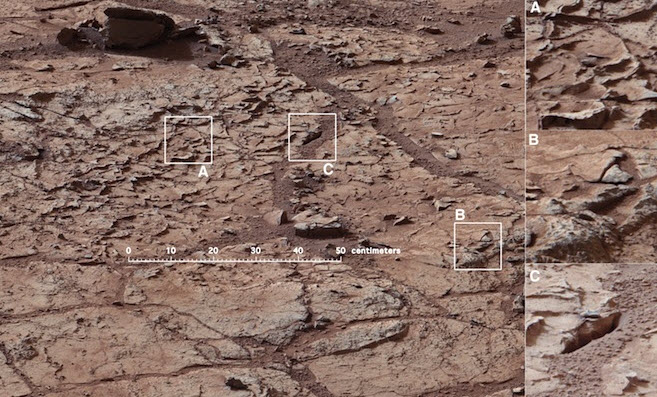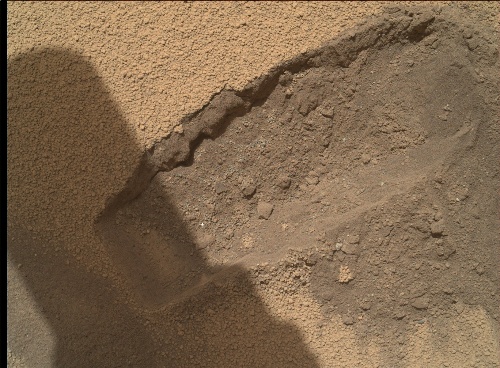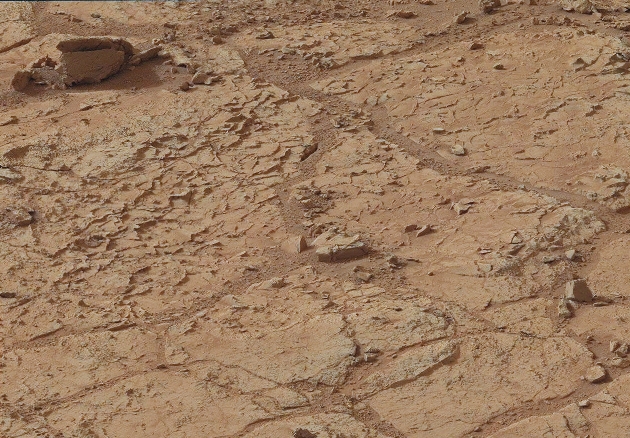It looks like you're using an Ad Blocker.
Please white-list or disable AboveTopSecret.com in your ad-blocking tool.
Thank you.
Some features of ATS will be disabled while you continue to use an ad-blocker.
4
share:
www.wired.com...
NASA’s Curiosity rover has explored a new area on Mars called Yellowknife Bay, which shows plenty of evidence of flowing water. The rover is preparing to drill into a rock nicknamed “John Klein” in the location in the next couple weeks, investigating its composition and searching for organics. This will be the first time that engineers have drilled into the surface of another planet.
Scientists already know that Curiosity’s explorations have taken it to a place that was basically an ancient riverbed. Now they are uncovering the complex geologic history of the area and have stumbled across many interesting features.

“The scientists have been let into the candy store,” said engineer Richard Cook, project manager for Curiosity, during a NASA teleconference on Jan. 15.
For the last few weeks, the rover has been moving from the plateau it landed on down a slope into a depression. As it descended, it passed through layers of rock that are increasingly older, taking it backwards into the planet’s history. Geologists are finding a lot of different rock types, indicating that many different geologic processes took place here over time.
Some of the minerals are sedimentary, suggesting that flowing water moved small grains around and deposited them, and other evidence suggests water moved through the rocks after they had formed. Tiny spherical concretions scattered through the rock were likely formed when water percolated through rock pores and minerals precipitated out. Other samples are cracked and filled with veins of material such as calcium sulfate, that were also formed when water percolated through the cracks and deposited the mineral.
NASA’s Curiosity rover has explored a new area on Mars called Yellowknife Bay, which shows plenty of evidence of flowing water. The rover is preparing to drill into a rock nicknamed “John Klein” in the location in the next couple weeks, investigating its composition and searching for organics. This will be the first time that engineers have drilled into the surface of another planet.
Scientists already know that Curiosity’s explorations have taken it to a place that was basically an ancient riverbed. Now they are uncovering the complex geologic history of the area and have stumbled across many interesting features.

“The scientists have been let into the candy store,” said engineer Richard Cook, project manager for Curiosity, during a NASA teleconference on Jan. 15.
For the last few weeks, the rover has been moving from the plateau it landed on down a slope into a depression. As it descended, it passed through layers of rock that are increasingly older, taking it backwards into the planet’s history. Geologists are finding a lot of different rock types, indicating that many different geologic processes took place here over time.
Some of the minerals are sedimentary, suggesting that flowing water moved small grains around and deposited them, and other evidence suggests water moved through the rocks after they had formed. Tiny spherical concretions scattered through the rock were likely formed when water percolated through rock pores and minerals precipitated out. Other samples are cracked and filled with veins of material such as calcium sulfate, that were also formed when water percolated through the cracks and deposited the mineral.
Water on Mars...flowing water on Mars???
If that were true is outright proves that global warming has nothing to do with man doesn't it. It would prove that time and climate change are natural.
If that were true is outright proves that global warming has nothing to do with man doesn't it. It would prove that time and climate change are natural.
I find the whole Mars thing simply fascinating and am convinced that the millions/billions spent on this magnificent scientific journey will benefit
mankind for many thousands of years to come.
/sarcasm=off
/sarcasm=off
reply to post by CaptainBeno
thanks this is interesting. How long is the drill bit?
Is the curiosity rover water proof?
thanks this is interesting. How long is the drill bit?
Is the curiosity rover water proof?
Originally posted by pacifier2012
Water on Mars...flowing water on Mars???
If that were true is outright proves that global warming has nothing to do with man doesn't it. It would prove that time and climate change are natural.
The axis changes over millions of years of a planet, and the results of an artificially and negatively impacted atmosphere, are two completely separate things.
There was water, flowing and liquid, once on Mars.
Originally posted by LightSpeedDriver
I find the whole Mars thing simply fascinating and am convinced that the millions/billions spent on this magnificent scientific journey will benefit mankind for many thousands of years to come.
/sarcasm=off
Dag nabbit, why are those fellers tinkering with that wiring and electro stuff. Who needs it. If it's dark outside, thats when ya do yer sleeping and sexin'.. Or ya use that thar candle.
Who needs all this explorin' and inventin'..
The area around A & C looks like a dry mud surface gone crusty.
Area B looks like an alien
Area B looks like an alien
reply to post by CaptainBeno
Curiosity recently practiced using its brushes to remove the dust from a rock in Yellowknife Bay. Are they planning to do the same to the area to be drilled? I would if I were running the mission (and who's to say I'm not?) so the exact drilling spot could be chosen with even more of an eye to the detail under the dust. This would also give the drill just a little more dust free environment, so it would drill into oldest-rock all the way down without even a grain of excess dust on the drill bit. Judging from past gifs put up by impaired we will be able to see some of the drilling process not long after it occurs. Nice thread, thanks.
Curiosity recently practiced using its brushes to remove the dust from a rock in Yellowknife Bay. Are they planning to do the same to the area to be drilled? I would if I were running the mission (and who's to say I'm not?) so the exact drilling spot could be chosen with even more of an eye to the detail under the dust. This would also give the drill just a little more dust free environment, so it would drill into oldest-rock all the way down without even a grain of excess dust on the drill bit. Judging from past gifs put up by impaired we will be able to see some of the drilling process not long after it occurs. Nice thread, thanks.
edit on 16-1-2013 by Aleister because: (no reason given)
edit on 16-1-2013 by
Aleister because: (no reason given)
reply to post by LeLeu
Looking at these pictures I'm yearning to see a couple of strong astro/cosmo/chinese-nauts with shovels digging a hole into this stuff and getting down into it within seconds. Maybe this mission will finally get the world focused and teamed-up on a manned Mars mission, and just "do it already". But that's the benefit of the great cameras on Curiosity, they make people like me want more of the same and then better. Some of us Martians-at-heart won't be satisfied until we have boots on the ground and shovels very deep into the ground.
Looking at these pictures I'm yearning to see a couple of strong astro/cosmo/chinese-nauts with shovels digging a hole into this stuff and getting down into it within seconds. Maybe this mission will finally get the world focused and teamed-up on a manned Mars mission, and just "do it already". But that's the benefit of the great cameras on Curiosity, they make people like me want more of the same and then better. Some of us Martians-at-heart won't be satisfied until we have boots on the ground and shovels very deep into the ground.
Why isn't this covered over with dust if it's ancient, and why does it look still damp in parts...?!?...it looks like it dried up yesterday.
Originally posted by Kantzveldt
Why isn't this covered over with dust if it's ancient, and why does it look still damp in parts...?!?...it looks like it dried up yesterday.
Exactly! I've asked the same thing myself. It's supposedly many tens of millions of years old, years in which massive dust storms and Martian squirrels and flowers roamed the planet at will, and here all they have to do is brush a little dust aside with a couple robot-brushes and you have ancient stone. I haven't heard a good answer to this, other than the wind blows it in then blows it off (there is more dust up against some of the rock overhangs, but not nearly enough to account for tens of millions of years of wind). There is no mystery, though, because there it is, ipso facto presto chango.
edit on 16-1-2013 by Aleister because: (no reason given)
reply to post by LeLeu
Is it possible the runoffs were made by lava? They do look like water channels.
Is it possible the runoffs were made by lava? They do look like water channels.
Originally posted by pacifier2012
Water on Mars...flowing water on Mars???
If that were true is outright proves that global warming has nothing to do with man doesn't it. It would prove that time and climate change are natural.
Yes -- climate change on Mars was natural.
Mars first lost its magnetic field, which allowed solar winds to strip away most of its atmosphere over hundreds of millions of year. Without a thick atmosphere, there was very little air pressure on Mars, and with such a low air pressure there can't be liquid water. Air pressure on Earth is what basically "holds" molecules in place in liquid form.
So, yeah; this change on Mars was natural...
...HOWEVER, (and without even arguing the causes of Earth global warming) I don't see how this loss-of-atmosphere on Mars is analogous to anything happening on Earth.
Oh, and yes -- it has been know for quite some time that mars once had flowing water. The landing site of Curiosity was chosen because NASA thinks that area (Gale Crater) could have once been very wet. Gale Crater maybe even once held a lake or a sea. Orbital analysis of the area showed the presence of clays and sulfates -- both of which form in watery environments. A few years ago, the rover Opportunity found gypsum deposits at another part of Mars; gypsum is another mineral that requires water to form.
edit on 1/16/2013 by Soylent Green Is People because: (no reason given)
Originally posted by Kantzveldt
Why isn't this covered over with dust if it's ancient, and why does it look still damp in parts...?!?...it looks like it dried up yesterday.
It is covered with fine reddish dust, to a varying degree. The martian wind also picks up and deposits dust over time, so things don't just get buried under tons of dust forever. There is no damp there, it's just that the soil underneath the upper layer of dust is darker, and gets exposed in places, for example under the rover's wheels, in the in wind-blown dunes and ripples, or in the place where the rover used its scoop:

On a side note, that colour-balancing done by NASA looks horrible. Here's my version of the drill site:

new topics
-
President BIDEN's FBI Raided Donald Trump's Florida Home for OBAMA-NORTH KOREA Documents.
Political Conspiracies: 3 hours ago -
Maestro Benedetto
Literature: 4 hours ago -
Is AI Better Than the Hollywood Elite?
Movies: 5 hours ago -
Las Vegas UFO Spotting Teen Traumatized by Demon Creature in Backyard
Aliens and UFOs: 8 hours ago -
2024 Pigeon Forge Rod Run - On the Strip (Video made for you)
Automotive Discussion: 9 hours ago -
Gaza Terrorists Attack US Humanitarian Pier During Construction
Middle East Issues: 9 hours ago -
The functionality of boldening and italics is clunky and no post char limit warning?
ATS Freshman's Forum: 10 hours ago -
Meadows, Giuliani Among 11 Indicted in Arizona in Latest 2020 Election Subversion Case
Mainstream News: 11 hours ago -
Massachusetts Drag Queen Leads Young Kids in Free Palestine Chant
Social Issues and Civil Unrest: 11 hours ago
top topics
-
President BIDEN's FBI Raided Donald Trump's Florida Home for OBAMA-NORTH KOREA Documents.
Political Conspiracies: 3 hours ago, 23 flags -
Krystalnacht on today's most elite Universities?
Social Issues and Civil Unrest: 14 hours ago, 9 flags -
University of Texas Instantly Shuts Down Anti Israel Protests
Education and Media: 17 hours ago, 8 flags -
Weinstein's conviction overturned
Mainstream News: 12 hours ago, 8 flags -
Supreme Court Oral Arguments 4.25.2024 - Are PRESIDENTS IMMUNE From Later Being Prosecuted.
Above Politics: 14 hours ago, 8 flags -
Massachusetts Drag Queen Leads Young Kids in Free Palestine Chant
Social Issues and Civil Unrest: 11 hours ago, 7 flags -
Gaza Terrorists Attack US Humanitarian Pier During Construction
Middle East Issues: 9 hours ago, 7 flags -
Las Vegas UFO Spotting Teen Traumatized by Demon Creature in Backyard
Aliens and UFOs: 8 hours ago, 6 flags -
Meadows, Giuliani Among 11 Indicted in Arizona in Latest 2020 Election Subversion Case
Mainstream News: 11 hours ago, 5 flags -
2024 Pigeon Forge Rod Run - On the Strip (Video made for you)
Automotive Discussion: 9 hours ago, 4 flags
active topics
-
Hate makes for strange bedfellows
US Political Madness • 47 • : 19Bones79 -
-@TH3WH17ERABB17- -Q- ---TIME TO SHOW THE WORLD--- -Part- --44--
Dissecting Disinformation • 689 • : daskakik -
University of Texas Instantly Shuts Down Anti Israel Protests
Education and Media • 265 • : Astrocometus -
Gaza Terrorists Attack US Humanitarian Pier During Construction
Middle East Issues • 27 • : ToneD -
Reason of the Existence
The Gray Area • 21 • : BingoMcGoof -
President BIDEN's FBI Raided Donald Trump's Florida Home for OBAMA-NORTH KOREA Documents.
Political Conspiracies • 10 • : nugget1 -
Supreme Court Oral Arguments 4.25.2024 - Are PRESIDENTS IMMUNE From Later Being Prosecuted.
Above Politics • 85 • : Sookiechacha -
Chris Christie Wishes Death Upon Trump and Ramaswamy
Politicians & People • 24 • : nugget1 -
New whistleblower Jason Sands speaks on Twitter Spaces last night.
Aliens and UFOs • 63 • : pianopraze -
SETI chief says US has no evidence for alien technology. 'And we never have'
Aliens and UFOs • 74 • : Justoneman
4

